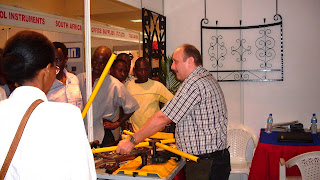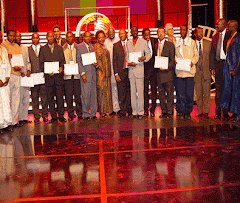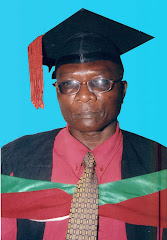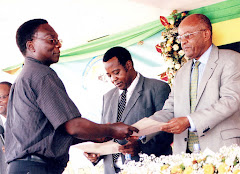
A placard carrying a welcoming message of the 11th East Africa Expo-Link trade exhibition as my Sumsung digital camera captured it at diamond Jubilee Hall in Dar es Salaam.
The significance of the trade exhibition is to showcase various product range being manufactured for normal consumption. The so-called Expolink is a major annual trade exhibitions organized by EXPOLINK GROUP worldwide which are Build East Africa, Auto East Africa, Kenya International Trade Exhibition, Tanzania International Trade Exhibition, Food Hotel & Kitchen, Machinery East Africa, Packaging Expo East Africa, Building & Mining Tanzania, Expo Yemen, Expo-Uganda, Expo-Ethiopia, Expo-Nigeria, Security East Africa, Telesat East Africa, Computers & Offices Africa, Expo Egypt. Build-expo Egypt - Egypt Building Exhibition, East Africa International Trade Exhibition, Build-expo East Africa, Medexpo East Africa, Medical Exhibition of East Africa and Fashion East Africa
East Africa 's International Multi-Sector Trade Exhibition attracting exhibitors from over 30 countries. Between 2004-2005 Expo-link exhibition was introduced with new trade exhibition such as Secure-expo East Africa International Trade exhibition on security and safety.

This is the reception leading to the exhibition hall on the right hand side

Former Deputy Permanent Secretary in the Ministry of Industry, Trade and Marketing Dr. Florens Turuka is being welcomed on his arrival by the organizers of the exhibition at the Diamond Jubilee Hall. With him are the exhibition organizers, trailing behind him is Mr. Edwin Rwehumbiza of the Board of External Trade and an official from the BET who co-hosted the function.
Expo-link is a proud member of the Expo Group, a prestigious name in the global exhibition industry with branches in more than 20 countries. The subsidiary was formed with the idea of organizing trade events in various emerging markets, emphasizing on Africa, Middle East, Australia and the Indian continent. In 2002, Expo group celebrated its 10th international trade exhibition covering 17 countries within a period of 10 years. Reasons behind the success have been many, but those contributing most are identifying potential markets and offering a whole world of services.

Former deputy Permanent Secretary in the Ministry of Industry, Trade and Marketing Dr. Florens Turuka in his capacity by then, cuts a tape as a Chief guest of honour to officially open the 11th East Africa International Trade Expo 2008 in Dar es Salaam last year. A three day occasion which took place at Diamond Jubilee hall was attended by mostly businessmen in the city. Dr. Florens is now full Permanent Secretary in the Ministry of Information Culture and Sports following recent changes made by President Jakaya Kikwete.
Expo group worldwide also includes countries in European countries such as France, Italy and the Netherlands. The group also plans to carry out exhibition in Melbourne Australia which will be Expo-link Australia’s first International trade exhibition on new products based on the current technological applications, Infrastructure Products and those related in Building and construction of city planning etc.

Dr. Florens Turuka is being briefed by an exhibitor, a German national when he started a tour of the pavilions inside a hall. He is briefed on how some medical facilities and modern medical equipment work.

The PS is being introduced by an exhibitor on arrival at their pavilion

Dr. Florens Turuka is being briefed by an exhibitor Mr. Mfuru Mmiku, a Technical and Application Specialist of Health and Safety (T) Ltd company on how the Haemotology analyzer machine for blood testing works. This was when the PS toured the company’s pavilion which was among the participants in a three day East Africa International Trade Expo 2008 held in October this year at Diamond Jubilee hall in Dar es Salaam. Health and Safety (T) Ltd company is a sole supplier of medical laboratories equipment and reagents in the country which are being manufactured by a Japanese based Sysmex company.

Mr. Ronald Njabulo Shumba, a Zimbabwean national working for Sysmex South Africa as a Technical Product Specialist showing a visitor how Haemotology analyzer machine for blood testing works and how it gives results of a patient tested during the exhibition. Mr. Shumba is a Territory Manager for the company representing Africa region.

This is Health and Safety (T) company Limited whereby visitors thronged to see how medical equipment that belongs to the company known as blood-analyzer conducts blood cell testing

The PS as he moves around various pavilions. His presence as the guest of honour created a happy atmosphere as most exhibitors showed a grin of happiness in their eyes wherever he visited.



















































